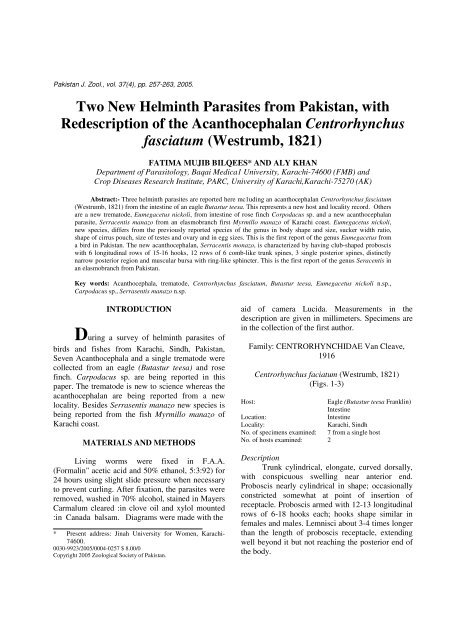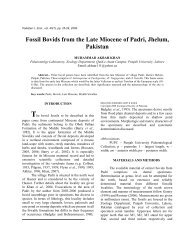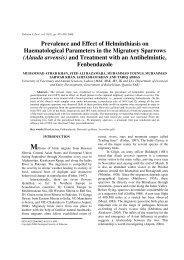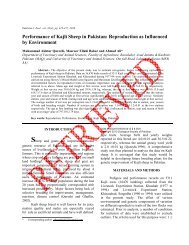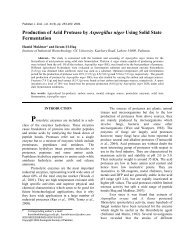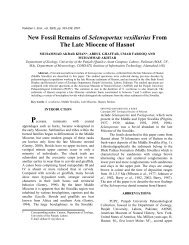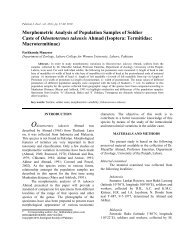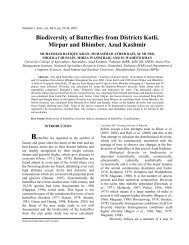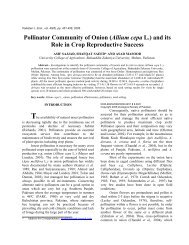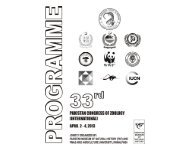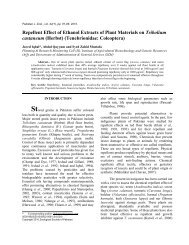Two New Helminth Parasites from Pakistan, with ... - Zsp.com.pk
Two New Helminth Parasites from Pakistan, with ... - Zsp.com.pk
Two New Helminth Parasites from Pakistan, with ... - Zsp.com.pk
You also want an ePaper? Increase the reach of your titles
YUMPU automatically turns print PDFs into web optimized ePapers that Google loves.
<strong>Pakistan</strong> J. Zool., vol. 37(4), pp. 257-263, 2005.<br />
<strong>Two</strong> <strong>New</strong> <strong>Helminth</strong> <strong>Parasites</strong> <strong>from</strong> <strong>Pakistan</strong>, <strong>with</strong><br />
Redescription of the Acanthocephalan Centrorhynchus<br />
fasciatum (Westrumb, 1821)<br />
FATIMA MUJIB BILQEES* AND ALY KHAN<br />
Department of Parasitology, Baqai Medica1 University, Karachi-74600 (FMB) and<br />
Crop Diseases Research Institute, PARC, University of Karachi,Karachi-75270 (AK)<br />
Abstract:- Three helminth parasites are reported here mc1uding an acanthocephalan Centrorhynchus fasciatum<br />
(Westrumb, 1821) <strong>from</strong> the intestine of an eagle Butastur teesa. This represents a new host and locality record. Others<br />
are a new trematode, Eumegacetus nickoli, <strong>from</strong> intestine of rose finch Corpodacus sp. and a new acanthocephalan<br />
parasite, Serracentis manazo <strong>from</strong> an elasmobranch first Myrmillo manazo of Karachi coast. Eumegacetus nickoli,<br />
new species, differs <strong>from</strong> the previously reported species of the genus in body shape and size, sucker width ratio,<br />
shape of cirrus pouch, size of testes and ovary and in egg sizes. This is the first report of the genus Eumegacetus <strong>from</strong><br />
a bird in <strong>Pakistan</strong>. The new acanthocephalan, Serracentis monazo, is characterized by having club-shaped proboscis<br />
<strong>with</strong> 6 longitudinal rows of 15-16 hooks, 12 rows of 6 <strong>com</strong>b-like trunk spines, 3 single posterior spines, distinctly<br />
narrow posterior region and muscular bursa <strong>with</strong> ring-like sphincter. This is the first report of the genus Seracentis in<br />
an elasmobranch <strong>from</strong> <strong>Pakistan</strong>.<br />
Key words: Acanthocephala, trematode, Centrorhynchus fasciatum, Butastur teesa, Eumegacetus nickoli n.sp.,<br />
Carpodacus sp., Serrasentis manazo n.sp.<br />
INTRODUCTION<br />
During a survey of helminth parasites of<br />
birds and fishes <strong>from</strong> Karachi, Sindh, <strong>Pakistan</strong>,<br />
Seven Acanthocephala and a single trematode were<br />
collected <strong>from</strong> an eagle (Butastur teesa) and rose<br />
finch. Carpodacus sp. are being reported in this<br />
paper. The trematode is new to science whereas the<br />
acanthocephalan are being reported <strong>from</strong> a new<br />
locality. Besides Serrasentis manazo new species is<br />
being reported <strong>from</strong> the fish Myrmillo manazo of<br />
Karachi coast.<br />
MATERIALS AND METHODS<br />
Living worms were fixed in F.A.A.<br />
(Formalin" acetic acid and 50% ethanol, 5:3:92) for<br />
24 hours using slight slide pressure when necessary<br />
to prevent curling. After fixation, the parasites were<br />
removed, washed in 70% alcohol, stained in Mayers<br />
Carmalum cleared :in clove oil and xylol mounted<br />
:in Canada balsam. Diagrams were made <strong>with</strong> the<br />
* Present address: Jinah University for Women, Karachi-<br />
74600.<br />
0030-9923/2005/0004-0257 $ 8.00/0<br />
Copyright 2005 Zoological Society of <strong>Pakistan</strong>.<br />
aid of camera Lucida. Measurements in the<br />
description are given in millimeters. Specimens are<br />
in the collection of the first author.<br />
Family: CENTRORHYNCHIDAE Van Cleave,<br />
1916<br />
Centrorhynchus faciatum (Westrumb, 1821)<br />
(Figs. 1-3)<br />
Host:<br />
Eagle (Butastur teesa Franklin)<br />
Intestine<br />
Location:<br />
Intestine<br />
Locality:<br />
Karachi, Sindh<br />
No. of specimens examined: 7 <strong>from</strong> a single host<br />
No. of hosts examined: 2<br />
Description<br />
Trunk cylindrical, elongate, curved dorsally,<br />
<strong>with</strong> conspicuous swelling near anterior end.<br />
Proboscis nearly cylindrical in shape; occasionally<br />
constricted somewhat at point of insertion of<br />
receptacle. Proboscis armed <strong>with</strong> 12-13 longitudinal<br />
rows of 6-18 hooks each; hooks shape similar in<br />
females and males. Lemnisci about 3-4 times longer<br />
than the length of proboscis receptacle, extending<br />
well beyond it but not reaching the posterior end of<br />
the body.
258<br />
F.M. BILQEES AND A. KHAN<br />
Remarks<br />
Body 10.10-11.1 by 1.2-1.5. Greatest width at<br />
anterior swelling. Proboscis 0.72 to 0.74 long, 0.18<br />
to 0.19 width at tip, 0.30-0.31; width near middle,<br />
0.20-0.21 width at base, hooks measures 0.019-<br />
0.021 long at tip and 0.018-0.019Iong at middle,<br />
neck absent, lemnisci long, 5.46.9 long. Proboscis<br />
receptacle 0.91-0.92 by 0.21-0.22. Testes oval,<br />
tandem, sometimes overlapping, 0.05-0.5 by 0.04-<br />
0.42, located in anterior swelling of trunk. Three<br />
cement glands present. Bursa large, well developed,<br />
membranous, measuring 0.32-.0.62 by 0.63.<br />
tip, 1.17 wide at middle, 0.3 wide at base. Hooks<br />
measurer 0.006-0.010 at tip, 0.018-0.020 at middle<br />
and 0.09 at base of proboscis. Lemnisci and<br />
proboscis receptacle as in male. Eggs in body cavity<br />
of female, oval, measuring 0.004-0.005 by 0.05-0.06<br />
<strong>with</strong>out polar prolongations, thin outer shell<br />
sculptured <strong>with</strong> very thin longi1ndinal ridges and<br />
grooves.<br />
Fig. 2. Centrorhynchus fasciatum,<br />
proboscis enlarged.<br />
Fig. 1. Centrorhynchus fasciatum<br />
Westrumb, 1821; a, entire male; b, hooks<br />
enlarged; c, anterior end of male; d, bursal<br />
region.<br />
Female<br />
Body 14.5-15.6 by 0.5-1.1. Greatest width at<br />
anterior swelling. Proboscis 1.5 long, 0.2 wide at<br />
Remarks<br />
A number of species of the genus<br />
Centrorhynchus (Luhe, 1911) have been reported<br />
<strong>from</strong> different localities of the world.<br />
C. indicum Golvan, 1956, syn. G. fa1conis<br />
(Das, 1949); C. albidum Meyer, 1932, C. areolatum<br />
(Rud, 1819); C. asturinum (Johnst., 1913); C.
TWO NEW HELMINTH PARASITES FROM PAKISTAN 259<br />
bancrofti (Johnston and Best, 1943); C.<br />
baza1eticum Kuraschvili, 1965; C. bengalense Datta<br />
and Soota, 1955; C. brellicanthus Das, 1949; C.<br />
bubonia Yamaguti, 1959; C. buteonis (Schrank,<br />
1788) Kostyle, 1914; C. chahaudi Golvan, 1958; C.<br />
1953; C. lanceoides (Petrotschenko, 1949); C.<br />
leguminosum (Solowjew, 1912); C. macrorchis Das,<br />
1950; C. madagascariense (Golvan, 1957); C.<br />
maryasis Datta, 1933; C. microcephalus Bravo<br />
Hollis, 1947; C. microrchis Fukui, 1929; C. milvus<br />
Ward, 1956; C. narciseae Florescu, 1942; C.<br />
petrotschenkoi Kuraschvili, 1955; C. physocoracis<br />
(Porta, 1913); C. picae Dollfus, 1953; C. undalatum<br />
Dollfus, 1951); C. turdi Yamaguti., 1939; C.<br />
tumidulum (Rud, 1819); C. kuntzi Schmidt, 1966; C.<br />
crotophagicolan Schmidt, 1966; C. nicaraguensis<br />
Schmidt, 1966 (in Yamaguti, 1963).<br />
The above species are reported <strong>from</strong> Russia,<br />
S. America, India, Sudan, China, Chile, Australia,<br />
Africa, Morocco, Germany, <strong>Pakistan</strong>, Japan,<br />
Europe, Alaska, Romania, Congo, Belgium, and<br />
Canada.<br />
The species reported <strong>from</strong> <strong>Pakistan</strong> are C.<br />
nickoli Khan et al., 2001 and C. sindensis Khan et al<br />
2002.<br />
The present specimens are closer to C.<br />
fasciatum (Westrumb, 1821) Travassos 1926, in the<br />
size of the body and rows of proboscis hooks.<br />
Therefore, it is regarded as same <strong>with</strong> a new locality<br />
record for the first time in <strong>Pakistan</strong>.<br />
Family: EUMEGACETIDAE Travassos, 1923<br />
Eumegacetes nickoli, new species<br />
(Fig. 4)<br />
Fig. 3. Centrorhynchus fasciatum; a,<br />
entire female; b, eggs; c, anterior end of female.<br />
clitorideum (Meyer, 1931); C. conspectum (Van<br />
Cleave et Pratt. 1940); C. corvi Fuki, 1929; C.<br />
elongatum Yamaguti, 1935; C. embae Kostylew,<br />
1916; C. fa1conis (Johnston et Best, 1943); C.<br />
fasciatum (Westrumb, 1821); C. freundi (Hartwich,<br />
1953); C. galliardi Golvan, 1956; C. gendrei<br />
(Golvan, 1957); C. giganteum Travassos, 192 1; C.<br />
globocaudatum (Zeder, 1800); C. horridum<br />
(Linstow, 1897); C. hylae (.Johnston, 1941); C.<br />
leguminosum (Golvan, 1956); C. insulare Tubangui,<br />
Host:<br />
Rose finch (Ca1rodacus sp.)<br />
Location:<br />
Intestine<br />
Locality:<br />
Karachi, Sindh<br />
No. of specimens examined: 1, <strong>from</strong> a single host<br />
No. of host examined: 4<br />
Description<br />
Body oval to elongate, cuticle thin, smooth.<br />
Body size 2,4 mm greatest width, 1.1 in the<br />
acetabular region, forebody 1.0 and hindbody 0.6.<br />
Suckers strongly developed. Oral sucker 0.55 in<br />
transverse diameter, terminal in position.<br />
Acetabulum post equatorial, 0.55 in diameter.<br />
Sucker ratio 1:1; Pharynx 0.21 by 0.35; Esophagus<br />
lacking. Ceca bend anteriorly <strong>from</strong> the mid pharynx<br />
level. Genital pore is situated in the anterior region<br />
of the body ventral to pharynx. Testes inside the<br />
caecal arch, connected to each other by a delicate
260<br />
F.M. BILQEES AND A. KHAN<br />
Fig. 4. Eumegacetus nickoli, new species;<br />
a, holotype entire; b, eggs.<br />
duct, pre-acetabular in position, diameter of each<br />
testes being 0.22-0.29 they are smooth, rather oval<br />
and symmetrical. Cirrus pouch saccular,<br />
intertesticular, 5.2 long, and 0.3 in its maximum<br />
width. Ovary in the posterior third of the body 0.2<br />
by 0.19 in size, A tubular seminal receptacle arises<br />
<strong>from</strong> the side of ovary 0.3 by 0.04 in size. Shell<br />
gland 0.1 by 0.15, caeca end just behind the level of<br />
the ovary. Vitellaria lateral, consisting of flattened<br />
follicles of variable size intruding more or less up to<br />
the level of forebody and posteriorly near the<br />
posterior end.<br />
Excretory vesicle 'Y'-shaped. Uterus <strong>with</strong><br />
several transverse coiling filling most of the hind<br />
portion of the body, covering caeca. Eggs thin<br />
shelled, 0.026, 0.036 by 0.01-0.15.<br />
Remarks<br />
The genus Eumegacetes Loos, 1900 is<br />
cosmopolitan. The following species of the genus<br />
have been reported viz. E. triangularis, (Looss,<br />
1894) Looss, 1900; E. aquil1ai Jaiswal et Reddy,<br />
1968; E. hirundiosus Jaiswal Vasudev, 1960; E.<br />
indicus Jaiswal et Vasudev, 1960; E. 1anii<br />
Yamaguti et Mitinaga, 1943; E. lecitbrosalus<br />
Oshmarin, 1958; E. macroorchis Brenes madrigal et<br />
Anrroya Sancho, 1962; E. medioximus Braun, 1901;<br />
E. megactabulus Jaiswal et Vasudev, 1960; E.<br />
mehraii Jha, 1943; E. microdiosus Chauhan, 1940;<br />
E. perodiosus Travassos, 1922; E. riparius Gupta,<br />
1957; E. singhi Jaiswal, 1957 and E. skrjabini<br />
Tenora et Kopriva, 1958 (in Yamaguti, 1971).<br />
The present specimens of the genus<br />
Eumegacetes (Looss, 1900) have been reported for<br />
the first time <strong>from</strong> Carpodacus sp. (Rose finch) and<br />
<strong>from</strong> a new locality Karachi, <strong>Pakistan</strong>.<br />
The present species is closer to E. lanii<br />
Yamaguti and Mitunga, 1943 but differs <strong>from</strong> it in<br />
having the oral sucker and ventral sucker of equal<br />
diameter while in E. lanii the oral sucker appears a<br />
bit smaller than the acetabulum, vitellaria in E. lanai<br />
more profusely developed and its shape and size of<br />
the cirrus sac is also different. Ramadan et al.<br />
(1984) provided a key to differentiate species of<br />
Eumegacetes. Shumilo (1970) described E.<br />
variovitellus n.sp. <strong>from</strong> small intestine and caecae of<br />
Merops apiaster in Molderian, SSR.<br />
Isokova (1970) reported E. brevis <strong>from</strong> wild<br />
birds in Black sea area. El-Naffar and Khalifa<br />
(1980) described a new species E. upupae <strong>from</strong><br />
Egyptian hoopoe and E. orientalis little green<br />
Egyptian bee-eater. Dehmukh (1987) described E.<br />
thapari and E. soodi <strong>from</strong> small intestine of horned<br />
owl <strong>from</strong> Aurangabad, India.<br />
The new species is named in honour of Dr.<br />
Brent B. Nickol, Lincoln University, Nebraska,<br />
U.S.A.<br />
Serrasentis manazo, new species<br />
(Figs. 5A-B)<br />
Host<br />
Myrmillo manazo (Blkr)<br />
Location:<br />
Intestine<br />
Locality:<br />
Karachi coast, <strong>Pakistan</strong><br />
Number of parasites: 1 male specimen <strong>from</strong> a single host<br />
Host examined: 6
TWO NEW HELMINTH PARASITES FROM PAKISTAN 261<br />
<strong>com</strong>b-like spines, which are 12 in number followed<br />
by 3 small spines posteriorly. Proboscis clubshaped,<br />
wide anteriorly, <strong>with</strong> 6 longitudinal rows of<br />
15-16 hooks in each row, each hook covered at their<br />
roots by cuticular folds. Probosciss sheath doublelayered,<br />
leminisci two, longer than the proboscis<br />
receptacle, cylindrical. Cement glands probably four<br />
but not clearly seen. Bursa muscular <strong>with</strong> ring-like<br />
sphincter.<br />
Measurements<br />
Total length of the body 3.5, length of the<br />
Anterior portion 1.5, width of the anterior portion<br />
0.38, length of the posterior portion 1.4, width of the<br />
posterior portion 0.24, length of the Proboscis 0.7,<br />
width of proboscis 0.28 length of the proboscis<br />
receptacle 1.31, width. of the proboscis receptacle<br />
0.24, length of the hooks 0.048, length of <strong>com</strong>b-like<br />
trunk spines 0.034, width of trunk spines 0.012,<br />
length of the testes 0.064, width of testes 0.012.<br />
Bursa 0.5 in length.<br />
Fig. 5. Serrasentis manazo, new species;<br />
a, holotype entire male; b, proboscis hooks<br />
enlarged.<br />
Description<br />
Body small, slightly thinner at posterior end,<br />
anterior part of the trunk <strong>with</strong>. transverse rows of<br />
Remarks<br />
The acanthocephalan genus Serrasentis Van<br />
Cleave is peculiar in having variable number of<br />
<strong>com</strong>b-like trunk spines (Yamaguti, 1963). There is<br />
no other acanthocephalan genus <strong>with</strong> these peculiar<br />
type of trunk spines. Previously four species of the<br />
genus are known <strong>from</strong> bony fishes of Karachi coast.<br />
But the present specimen of the genus is <strong>from</strong> an<br />
elasmobranch Myrmillo manazo of Karachi coast<br />
Previous species of this genus have been reported<br />
<strong>from</strong> the fishes Pseudosciaena diacanthus,<br />
Rachycentron canadus (Bilqees, 1972), Otolithus<br />
argenteus (Bilqees and Kazmi,1974), Psettodes<br />
erumei, Musaenesax cinereus (Bilqees, 1981) and<br />
Cybius guttatum (Bilqees and Khatoon, 1992).<br />
Surface ultra-structure of two species were also<br />
reported by Bilqees (1981) and Bilqees and Kazmi<br />
(1992). Present specimens are new species for<br />
which the name Serrasentis manazo is proposed.<br />
The species of the genus described by now<br />
include S. longus (Tripatti, 1959), Bilqees and<br />
Kazmi, 1974; S. chauhani Datta, 1954; S. lamelliger<br />
Dies, 1854 (See Yamaguti, 1963); S. socialis<br />
Golvan, 1956; S. sagittifer Linton, 1932; S. mujibi<br />
and S. sciaena Bilqees, 1972, and S. giganticus<br />
Bilqees, 1972.
262<br />
F.M. BILQEES AND A. KHAN<br />
The present specimens differ <strong>from</strong> S. longus<br />
Tripathi, 1959 and S. sciaena Bilqees, 1972 in the<br />
shape, size, and number of proboscis hooks and the<br />
rows of cuticular <strong>com</strong>b-like spines present on the<br />
trunk. In S. longus, there are 19 rows of trunk<br />
spines, in S. sciaena there are 11 rows of <strong>com</strong>b-like<br />
trunk spines. The trunk of the present specimen is<br />
also smaller than the trunk of the S. longus and S.<br />
sciaena. In S. longus lemnisci are longer than the<br />
proboscis receptacle, whereas, in the former the<br />
leminisci are smaller than the proboscis receptacle.<br />
S. giganticus has a very large size and number of<br />
proboscis, and <strong>com</strong>b-like trunk spines are more in<br />
number than in all other spines.<br />
The species described <strong>from</strong> <strong>Pakistan</strong> are S.<br />
giganticus Bilqees, 1972b, S. longus (Tripathi,<br />
1959), Bilqees and Yasmin, 1974, S. mujibi Bilqees,<br />
1972a and S. sciaena Bilqees, 1972a and all are<br />
<strong>from</strong> bony fishes while the present new species is<br />
<strong>from</strong> an elasmobranch Myrmillo manazo. The<br />
species name S. manazo refers to the host.<br />
ACKNOWLEDGMENTS<br />
The parasites were collected and permanent<br />
slides were made by Nasim Fatima, one of our<br />
M.Sc. students.<br />
REFERENCES<br />
BILQEES, F.M., 1972a. <strong>Two</strong> new species of the genus<br />
Serrasentis (Acanthocephala: Rhadinorhynchidae <strong>from</strong><br />
some fishes of Karachi coast. <strong>Pakistan</strong> J. Sci., 24: 121-<br />
124.<br />
BILQEES, F.M., 1972b. Serrasentis giganticus n.sp.<br />
(Acanthocephala: Rhadinorhynchidae: Serrasentinae)<br />
<strong>from</strong> fishes of Karachi coast. Bull. agric. Res. Counc.<br />
<strong>Pakistan</strong>, pp. 41-47.<br />
BILQEES, F.M., 1981. Surface ultrastructure of Serrasentis<br />
longus (Tripathi, 1959) Bilqees and Kazmi, 1974 and<br />
Nybelina ewngaia Shah and Bilqees, 1979 <strong>from</strong> the<br />
fishes of Kamchi coast. <strong>Pakistan</strong> J. Zool., 13: 73-77.<br />
BILQEES, F.M. AND KAZRNI, F., 1974. <strong>Helminth</strong> parasite of<br />
a fish Otolithus argenteus (C.V) off the Karachi coast.<br />
Sindh Univ. Res. J., 8: 81-87.<br />
BRAUN, M., 1901. Zur Kenntnis der Trematoden der<br />
Saugetice. Zool. Jb. Syst., 14: 311-348.<br />
BRENES, M., RAMON, R. AND ARROYA SANCHO, G.,<br />
1962. <strong>Helminth</strong>us de la Republica de Costa Rica. XX.<br />
Algunos trematodes de aves silvestres. Rev. Biol. Trop.<br />
Univ. Costa Rica, 10: 205-227.<br />
CHAUHAN, B.S., 1940. <strong>Two</strong> new species of avian trematodes.<br />
Proc. Indian Acad. Sci.., 12: 75-83.<br />
DATTA, M.N., 1953. On a new species of acanthocephalan<br />
parasites <strong>from</strong> fishes of Bombay. Rec. Indian Mus., 51:<br />
15-20.<br />
DESHMUKH, A.U., 1987. On two new avian digenetic<br />
trematodes of the genus Eumegacetes Looss, 1900<br />
(Trematoda: Eumegacetidae). Riv. Parassitol., 48: 339-<br />
345.<br />
EL-NAFFAR, M.K. AND KHALIFA, R., 1980. Species of<br />
Eumegacetidae Trematoda <strong>from</strong> wild birds in assiut<br />
Province of Egypt. Acta Parasitol. Pol., 27: 279-284.<br />
GOLVAN, Y.J., 1956. Acanthocephales d’oiseux. Troisieme<br />
note. Revision des especes europennes de la sous<br />
famille des Plagiorhynchinae A. Meyer, 1931<br />
(Polymorphidae). Annls Parasit., 31: 350-384.<br />
GUPTA, N.K., 1957. On the new species of the genus<br />
Neodiplostomum Railliet, 1919 and on the validity of<br />
Neodiprostomum (Neodiplostamurn) rufeni Chatterji,<br />
1942. Res. Bull. Punjab Univ. Zool., 113: 327-335.<br />
JAISWAL, G.P., 1957. Studies of the trematode parasites of<br />
fishes and birds <strong>from</strong> Hyderabad State. I-V. Zool. Jb.<br />
(Syst.), 85: 1-72.<br />
ISKOVA, N.I., 1970. Phaneropsolus minor n.sp. and<br />
Eumegacetes (Anterovitelium) brevis n.sp. (Trematoda,<br />
Lecithodendriidae, Eumegacetidae), parasites of wild<br />
birds. Dopo vidi Akademii Nauk ukvainsikoi RJB, B<br />
(Geologiya, Geofizika, Khimyata Biologiya), 8: 748-<br />
741.<br />
JAISWA.L, G.P. AND REDDY, A.L., 1968. Investigations on<br />
the trematode fauna of Hyderabad, U.P. Pt II. <strong>Parasites</strong><br />
of birds – B. eumegacetes aquaillai n.sp. <strong>from</strong> an Indian<br />
Tawny eagle. Aquilla rapax vindhiana. Indian J.<br />
<strong>Helminth</strong>., 19: 126-131.<br />
JAISWA.L, G.P. AND VASUDEV, T., 1960. Studies on the<br />
avian trematodes belonging to the genus Eumegaretes<br />
Looss, 1900. Z. Par., 175-190.<br />
JHA, V.R., 1943. Three new diatomes of the family<br />
Lecithodenriidae. Proc. Indian Acad. Sci., 13, Sect B:<br />
9-19.<br />
KHAN, A., BILQEES, F.M. AND GHAZI, R.R., 2001.<br />
Acanthocephalan parasite Centrorhynchus nickoli. n.sp.<br />
<strong>from</strong> Eurasian roller (Coracias garrulous Linn.). Proc.<br />
Parasitol., 32: 33-39.<br />
KHAN, A., GHAZI, R.R. AND BILQEES, F.M., 2002. <strong>Two</strong><br />
new species of Acanothocephalan parasites of house<br />
crow (Corvus spendens Vieillot). <strong>Pakistan</strong> J. Zool., 34:<br />
139-146.<br />
LINTON, E., 1932. On the taxonomic position of<br />
Echinorhynchus sagittifex Linton. Science N.S., 76: 193.<br />
LOOSS, A., 1899. Weitere Beitrage zur Kenntris der<br />
Trematodenfauna Aegyplens, zugleich Ver such einer<br />
nathurlichen Gliederung des Genus Distomum Retzius.<br />
Zool. Jb. (Syst.), 12 521-784.<br />
LOOSS, A., 1900. Nachtragliche Bermerkungen zu den Namen<br />
der von mir Vorgeschlagener Distomengattungen. Zool.<br />
Anz., 23: 601-608.<br />
OSHMARIN, P.G., 1963. Parasite worms <strong>from</strong> mammals and<br />
birds of Primorskii Krai. Acad. Nauk, SSSR: 322.<br />
RAMADAN, A.M., SAOUD, M.F.A. AND ALY, A.M., 1989.
TWO NEW HELMINTH PARASITES FROM PAKISTAN 263<br />
A review of the genus Eumegacetes Looss, 1900.<br />
Eumegacetidae <strong>with</strong> description <strong>from</strong> the Egyptian<br />
housesparrow Passer-domesticus Niloticus. J. Egyptian<br />
Soc. Parasit., 19: 173-178.<br />
SHUMILO, P.R., 1970. Emugacetes variovitellus n.sp.<br />
(Trematoda: Eumegacetidae). Izvestiya Akademii Nauk<br />
Moldavskoi SSR Bologicheskie, Khimicheskie Nauki<br />
(1): pp. 50-53.<br />
TENORA, F. AND KAPRIVA, J., 1958. A new species of the<br />
trematode, Eumegacetes skrjabani sp.n. found in<br />
Delichon urbica in Czechoslovakia. Shorn. Vysok,<br />
Skoly, Zemedelsk a Lensniike Fak. Brne. Agron a<br />
Zootechn., 4: 451-453.<br />
TRAVASSOS, L., 1922. Informacoes para o conhecimentoda<br />
fauna helmintholojica a brasileira XVII. Gorgoderidae<br />
brasileiras. Mem. Inst. Osw., 15: 61-99.<br />
YAMAGUTI, S., 1963. Synopsis of digenetic trematodes of<br />
vertebrates. Keigaku Publishing Co. Tokyo, Japan, pp.<br />
1073.<br />
YAMAGUTI, S. AND MITUNGA, Y., 1973. Intestinal<br />
helminthes <strong>from</strong> Bufo melanostictus of Formosa. Trans.<br />
nat. Hist. Soc., Taiwan, 33: 300-311.<br />
(Received 22 March 2004, revised 16 April 2004)


